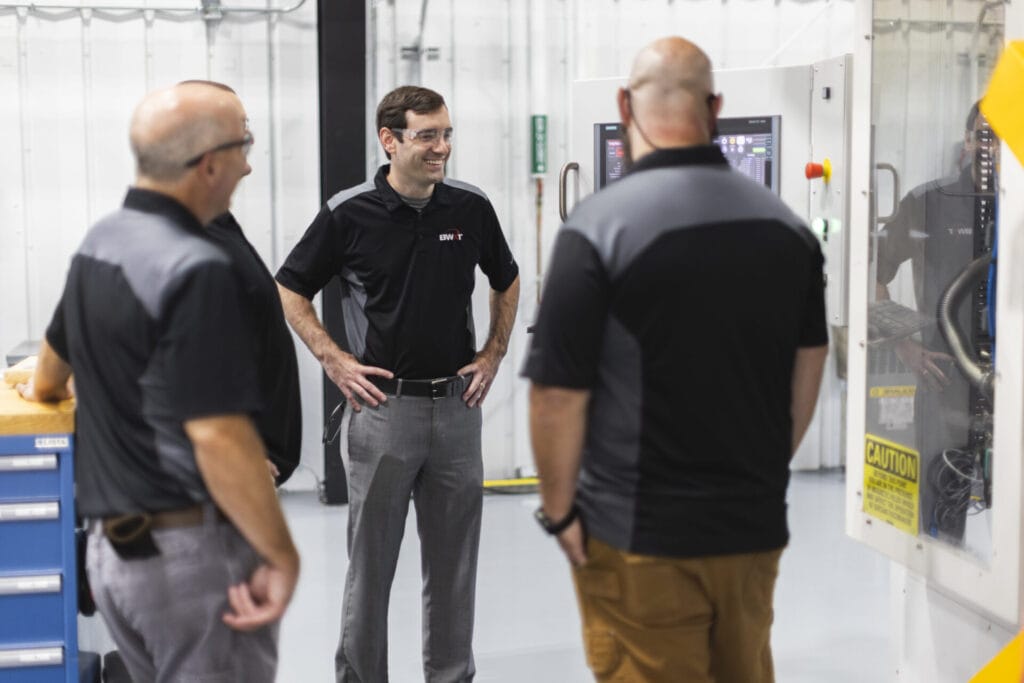Shane Stimpson’s Path to Nuclear
It’s not every day that a high school science experiment sparks a career in nuclear engineering. But Shane Stimpson didn’t go to just any high school.
Stimpson attended the Lynchburg-based Central Virginia Governor’s School, a magnet school for juniors and seniors focused on science and technology. “I was able to do an experiment where we irradiated samples of the element tungsten,” he remembers. “We sent the samples off to the Breazeale Reactor at Pennsylvania State University. It seemed pretty crazy—I think it still kind of is. There are only a handful of high schools that send off samples like that.”

Shane Stimpson pictured in the BWXT Showroom
For Stimpson, nuclear engineering carried a certain mystique. “Neutrons are mysterious because you can’t see them directly, but they’re super powerful,” he says. “Because of neutrons and fission, we’re able to extract a ton of power from a small amount of fuel, especially in comparison to other energy sources.”
After securing his undergrad at Georgia Tech and master’s and Ph.D. at the University of Michigan, Stimpson got a job at Oak Ridge National Lab, just outside of Knoxville. There, he spent six years focusing on computational method development for light-water nuclear reactors. “It was really rewarding to see impacts on the overall project, but I wanted to explore options that had a path to building a new reactor.”

Like a lot of people, Stimpson decided to make a career move during the COVID years. He’d previously interned with BWX Technologies in Lynchburg and was hearing good things about their Advanced Technologies (AT) division, such as its exciting progress in medical isotope production.
Plus, he already knew he liked the culture. “During my internship with BWXT, I worked with a group of people focused on designing a small modular reactor,” he says. “It seemed like they all appreciated that this was a cutting-edge project, and it was fun being a part of that team working with a shared goal.”

Now, as a technical integrator for nuclear thermal propulsion projects at AT, Stimpson analyzes reactor designs from multiple perspectives. “As we progress these reactor designs, we do nuclear, thermal, and mechanical analyses to ensure we have a good, multiphysics representation of the design,” he explains.
But what is a nuclear reactor, exactly? In a nutshell, it’s a technology used at nuclear power plants that generates clean energy. BWX Technologies is known for its work with the U.S. government—providing safe and effective nuclear solutions for national security, clean energy, environmental restoration, and even nuclear medicine and space exploration.
“I like working for BWXT because of its breadth of projects,” says Stimpson. “All are trying to target something that will help advance society in some way.”

The medical isotope sector, for example, aids with diagnostic imaging and radiotherapeutic treatments. Or the defense-focused microreactor projects that could help provide energy to military outposts. “Traditionally, that’s been through diesel, but there are a lot of associated risks with diesel,” Stimpson explains. “It also requires a lot of loads to get to the outpost because they use such a large volume. With a nuclear reactor, you’re able to provide substantial amounts of energy with less risk.”
Stimpson appreciates BWXT’s impact and its culture. “Throughout the company, there’s a lot of pride in terms of making sure we’re meeting national targets and goals that are useful to the country,” he says.
It’s convenient that BWXT’s home is in Lynchburg, as the city carries the added bonus of being a great place to live—and raise a family. Shane and his wife of 12 years have a six-year-old daughter. “There’s always a ton to do,” he says. “I play golf and disc golf in my free time and enjoy hiking in the area.”
It’s not unusual to find him at Peaks View Park’s disc golf course. “It’s mostly open, so I can throw it a little more wildly,” Stimpson laughs.
He adds that in Lynchburg, the living is easy. “There are a lot of people, but it doesn’t feel crowded. There’s a sense of calm, and even in general, traffic is good.”

Still, it’s easy to get to bigger cities, for fun or for work. As incoming vice chair for the American Nuclear Society’s reactor physics division, Stimpson expects he’ll be able to take advantage of the city’s close proximity to D.C. in the coming months for meetings with fellow society members from across the country.
Through his work, Stimpson is excited about the increased exposure of BWXT projects that he hopes will help improve the public’s perception of nuclear energy. Recently, Stimpson was included on the team to complete the final design of the nuclear reactor, manufacture of the reactor’s hardware and fuel, assemble the components, and deliver the fueled reactor as a complete subsystem for integration into the Defense Advanced Research Projects Agency’s (DARPA) Demonstration Rocket for Agile Cislunar Operations, known as DRACO. “It’s been a long time since we’ve built new nuclear plants in the U.S.,” he says. “There’s a fear of the unknown, and there’s a belief that nuclear energy can be dangerous.”
But, he adds, “a lot of extremely useful things involve risk. As long as you maintain proper regulations and treat it with care, you can take advantage of the benefits while still maintaining safety.”
Not only is it a reliable source of energy—it’s not dependent on the weather and releases less radiation into the environment than any other major energy source—but nuclear is also a long-term solution. “We have several centuries’ worth of nuclear fuel that we can extract and use,” Stimpson says. “It has a much longer sustainability lifetime than other forms of energy.”

Robin Sutton Anders is a Greensboro, N.C.-based writer and the managing editor of Verdant Word Communications.